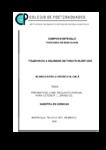| dc.description.abstract | La presente investigación se llevó a cabo en la empresa Vegetales de
Teotihuacan S. A de C. V. ubicada en Teotihuacan, de agosto a diciembre de
2007. Se estudió el efecto de los injertos de tomate Maxifort (MX), Multifort (MF),
Beaufort (BF) y de cuatro concentraciones de NaCl (0, 50, 100 y 150 mM)
suministradas en la solución nutritiva Steiner sobre la altura de planta, diámetro
de tallo, fotosíntesis, rendimiento, peso fresco y seco, calidad de fruta,
concentración nutrimental y contenido de prolina en hojas. Se utilizó el híbrido
Caimán sobre los portainjertos y éste mismo se usó como control (NI). Los
resultados indican una disminución de altura de planta, diámetro de tallo,
fotosíntesis y rendimiento, al aumentar el NaCl en la solución nutritiva. La altura
de la planta disminuyó 35.2, 24.96, 34.2 y 40% en NI, MX, MF y BF,
respectivamente. Respecto a diámetro de tallo, las plantas injertadas sobre MX
fueron las que presentaron menor descenso (4.8%) por efecto de la salinidad al
final del ciclo del cultivo. La fotosíntesis disminuyó 34.7% en las plantas sin
injertar y 2, 25.4 y 23.4% en las injertadas sobre MX, MF y BF, respectivamente al
incrementar los niveles de NaCl de 0 a 100 mM. El rendimiento disminuyó 90.6,
86.7, 86.0 y 82.5% en las plantas sin injertar y en las injertadas sobre MX, MF y
BF respectivamente, al incrementar de 0 a 150 mM el NaCl. En el caso del peso
seco y fresco, se encontró que desde 0 a 150 mM de NaCl, las plantas sin injertar
presentaron menor crecimiento comparadas con las injertadas. La interacción
portainjertos x NaCl afectó el color del fruto, sin presentar ninguna tendencia
definida. La salinidad no afectó la firmeza de los frutos, pero si su sabor, ya que al
incrementar la concentración de sal en la solución nutritiva, también lo hizo la
acidez titulable y lo sólidos solubles totales. Al aumentar la concentración de NaCl
en el medio de cultivo disminuyó la concentración de N, K, Ca y Mg; no obstante,
sucedió lo contrario para P, Mn, Zn y Na; en el Fe, B y Cu no existió efecto
alguno. La concentración de prolina en hojas aumentó al hacerlo el NaCl.________The present investigation was carried out in the company Vegetables de
Teotihuacan S.A. of C.V. located in Teotihuacan, from August to December of
2007. It was studied the effect of the grafts Maxifort (MX), Multifort (MF), Beaufort
(BF), and of four concentrations of NaCl (0, 50, 100, and 150 mM) provided in the
Steiner nutrient solution over height of plant, diameter of stem, photosynthesis,
yield, fresh and dry weight, quality of fruit, nutrimental concentration, and
concentration of proline in leaves. The Caiman hybrid was used over the
rootstocks and the same hybrid was utilized as control. The results indicated a
diminution in height of plant, diameter of stem, photosynthesis, and yield, when
increasing the NaCl in the nutrient solution. The height of the plant decreased
35.2, 24.96, 34.2, and 40% for NI, MX, MF, and BF, respectively. Regarding the
diameter of stem, the plants grafted on MX were those that presented less
reduction (4.8%) by effect of the salinity at the end of the cycle of the culture. The
photosynthesis diminished 34.7% in the plants without grafting and 2, 25.4, and
23.4% in the grafted ones on MX, MF, and BF, respectively when increasing the
levels of NaCl from 0 to 100 mM. Yield decreased 90.6, 86.7, 86.0, and 82.5% in
the plants without grafting and the grafted ones on MX, MF, and BF respectively,
when increasing from 0 to 150 mM. In the case of the dry and fresh weight, it was
found that plants supplied from 0 to 150 mM of NaCl no grafted plants displayed
minor growth compared to the grafted ones. The interaction of the rootstocks*NaCl
affected the color of the fruit, with no defined tendency. The salinity did not affect
the firmness of the fruit, but its flavor, since when increasing the concentration of
salt in the nutrient solution, also did the tritable acidity and the total soluble solids.
When increasing the concentration of NaCl in the solution it diminished the
concentration of N, K, Ca, and Mg; however, the opposite for P, Mn, Zn, and Na
happened; in the case of Fe, B, and Cu did not exist any effect. The concentration
of proline in leaves increased when increasing the levels of NaCl. | es |

